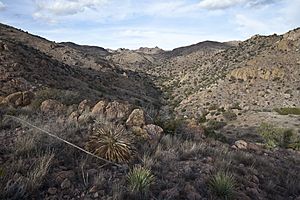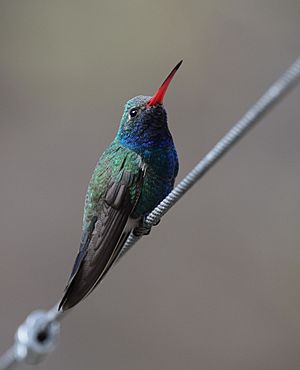Guadalupe Canyon facts for kids
Guadalupe Canyon is a canyon and valley in the southern portion of the Peloncillo Mountains Hidalgo County, New Mexico, Cochise County, Arizona and Agua Prieta Municipality, of Sonora. The waters of Guadalupe Canyon are tributary to the San Bernardino River joining it at its mouth at 31°13′33″N 109°16′10″W / 31.22583°N 109.26944°W just below Dieciocho de Augusto, Sonora. Its source is at 31°28′08″N 109°02′21″W / 31.46889°N 109.03917°W at an elevation of 6,160 feet on the south slope of Guadalupe Mountain (6,444 feet). It crosses the border into Mexico at 31°19′57″N 109°05′19″W / 31.33250°N 109.08861°W at an elevation of 4,173 feet/ 1,272 meters.
In 1864, the Mormon Battalion marched through Guadalupe Canyon. In 1881 the Guadalupe Canyon Massacre took place.
Habitat
The canyon is a wildlife corridor and provides habitat for violet-crowned hummingbirds and aplomado falcons. Other birds in the area are the broad-billed hummingbird, northern beardless tyrannulet, summer tanager, thick-billed kingbird, Elf Owl, black-tailed gnatcatcher, varied bunting, and wild turkey. The black-chinned hummingbird, and Costa's hummingbird also nest in the canyon.
Guadalupe canyon is also a wildlife corridor for Mexican gray wolves, and endangered jaguars, whose range bridges between the borders of both countries. Black bears, mountain lions, ocelots, and white-nosed coati also use the canyon as a corridor and hunting ground. The canyon area is a federally designated critical habitat for endangered wild feline.
Trees in the riparian habitat areas within the canyon include oak, Arizona sycamore, willow, and Freemont Cottonwood.
Hot springs
There are two hot spring zones in Guadalupe Canyon, Guadalupe Canyon Hot Springs and the Guadalupe Canyon Oasis. Primitive rock-lined soaking pools and waterfalls are found at both areas, however the latter is more developed and features a campground with flush toilets and hot showers. The hot mineral springs were used by Native Americans for centuries before the arrival of early settlers and itinerant animal herders. Thermal springs in the American Southwest were used for thousands of years, per archaeological evidence of human use and settlement by Paleo-Indians. There are numerous petroglyphs and ochre-pigmented rock art throughout the canyon.



